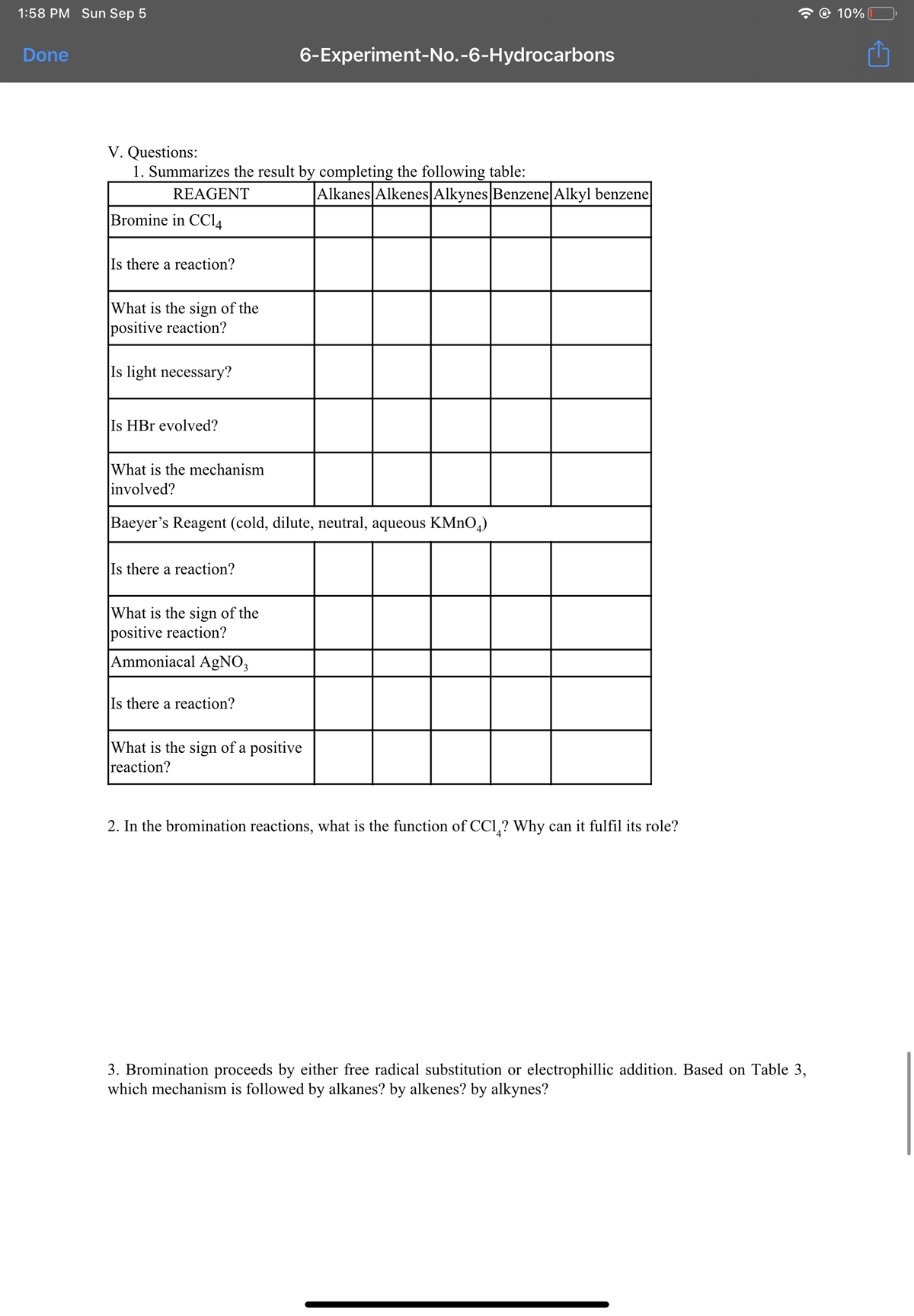V. Questions: 1. Summarizes the result by completing the following table: REAGENT |Alkanes Alkenes Alkynes Benzene|Alkyl benzene Bromine in CCI4 Is there a reaction? What is the sign of the |positive reaction? Is light necessary? Is HBr evolved? What is the mechanism involved? Baeyer's Reagent (cold, dilute, neutral, aqueous KMNO,) Is there a reaction? What is the sign of the positive reaction? Ammoniacal AgNO, Is there a reaction? What is the sign of a positive reaction?
V. Questions: 1. Summarizes the result by completing the following table: REAGENT |Alkanes Alkenes Alkynes Benzene|Alkyl benzene Bromine in CCI4 Is there a reaction? What is the sign of the |positive reaction? Is light necessary? Is HBr evolved? What is the mechanism involved? Baeyer's Reagent (cold, dilute, neutral, aqueous KMNO,) Is there a reaction? What is the sign of the positive reaction? Ammoniacal AgNO, Is there a reaction? What is the sign of a positive reaction?
Chapter20: Carboxylic Acids And Nitriles
Section20.SE: Something Extra
Problem 25MP: Acid-catalyzed hydrolysis of a nitrile to give a carboxylic acid occurs by initial protonation of...
Related questions
Question
complete the table

Transcribed Image Text:1:58 PM Sun Sep 5
O 10%
Done
6-Experiment-No.-6-Hydrocarbons
V. Questions:
1. Summarizes the result by completing the following table:
REAGENT
|Alkanes Alkenes Alkynes Benzene Alkyl benzene
Bromine in CCI4
Is there a reaction?
What is the sign of the
positive reaction?
Is light necessary?
Is HBr evolved?
What is the mechanism
involved?
Baeyer's Reagent (cold, dilute, neutral, aqueous KMNO,)
Is there a reaction?
What is the sign of the
positive reaction?
Ammoniacal AgNO3
Is there a reaction?
What is the sign of a positive
reaction?
2. In the bromination reactions, what is the function of CCl,? Why can it fulfil its role?
3. Bromination proceeds by either free radical substitution or electrophillic addition. Based on Table 3,
which mechanism is followed by alkanes? by alkenes? by alkynes?
Expert Solution
This question has been solved!
Explore an expertly crafted, step-by-step solution for a thorough understanding of key concepts.
Step by step
Solved in 5 steps with 1 images

Knowledge Booster
Learn more about
Need a deep-dive on the concept behind this application? Look no further. Learn more about this topic, chemistry and related others by exploring similar questions and additional content below.Recommended textbooks for you


Chemistry by OpenStax (2015-05-04)
Chemistry
ISBN:
9781938168390
Author:
Klaus Theopold, Richard H Langley, Paul Flowers, William R. Robinson, Mark Blaser
Publisher:
OpenStax

Organic Chemistry: A Guided Inquiry
Chemistry
ISBN:
9780618974122
Author:
Andrei Straumanis
Publisher:
Cengage Learning


Chemistry by OpenStax (2015-05-04)
Chemistry
ISBN:
9781938168390
Author:
Klaus Theopold, Richard H Langley, Paul Flowers, William R. Robinson, Mark Blaser
Publisher:
OpenStax

Organic Chemistry: A Guided Inquiry
Chemistry
ISBN:
9780618974122
Author:
Andrei Straumanis
Publisher:
Cengage Learning

Chemistry: Matter and Change
Chemistry
ISBN:
9780078746376
Author:
Dinah Zike, Laurel Dingrando, Nicholas Hainen, Cheryl Wistrom
Publisher:
Glencoe/McGraw-Hill School Pub Co